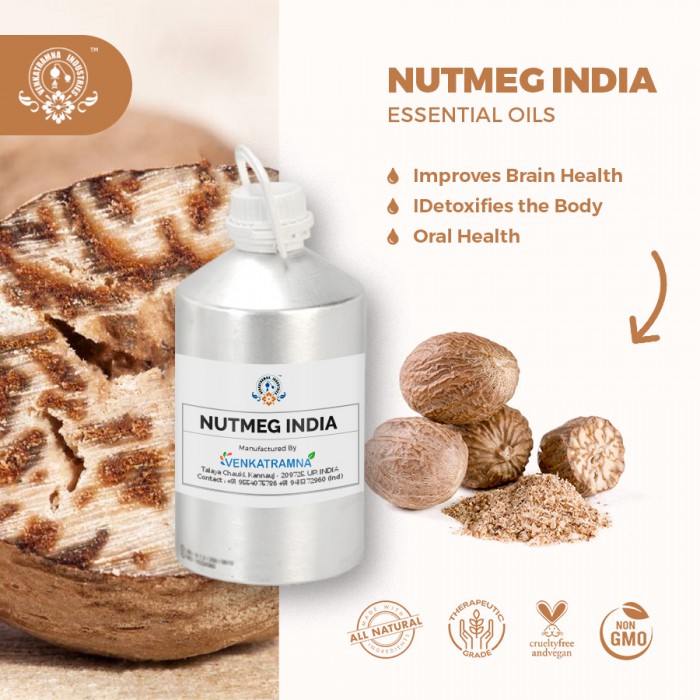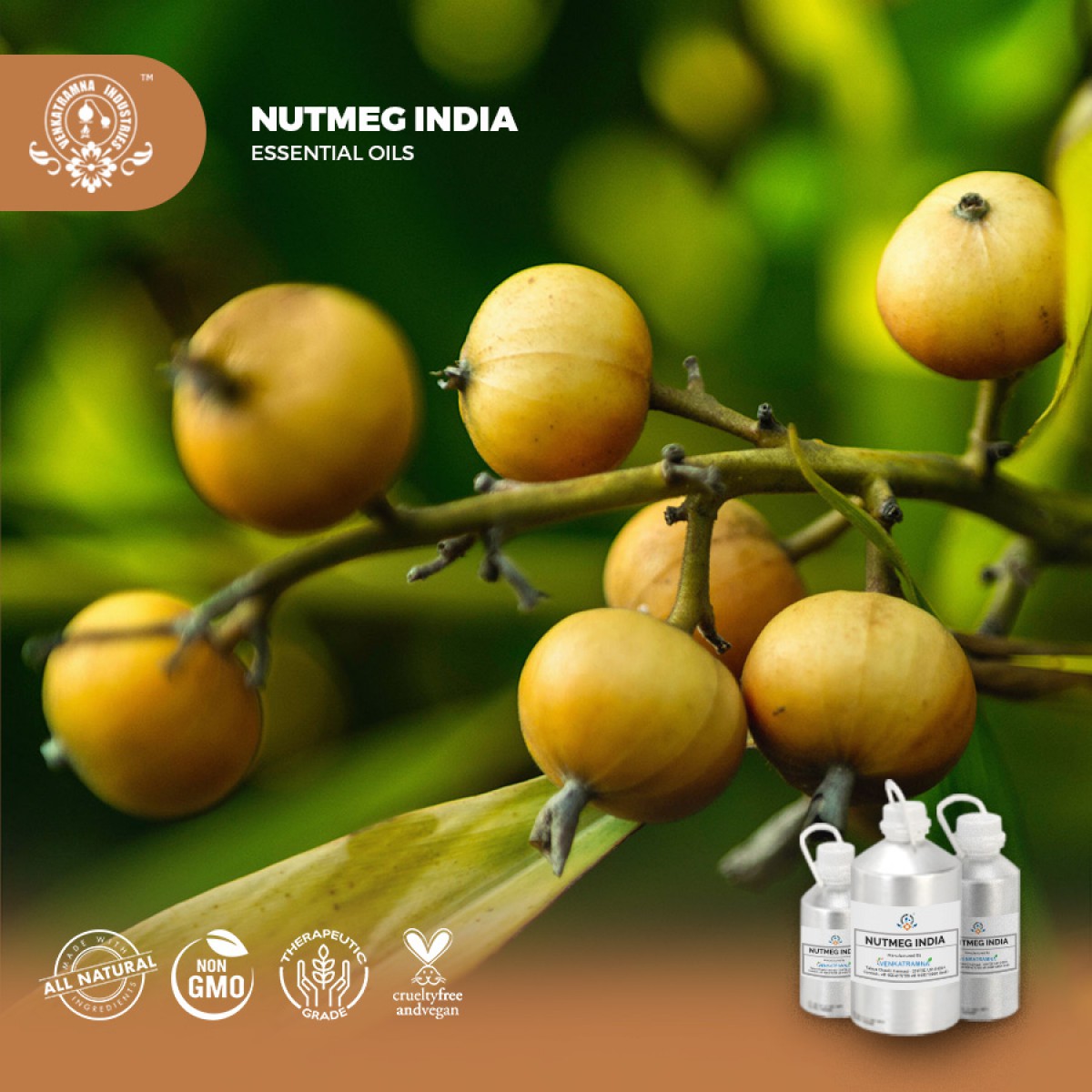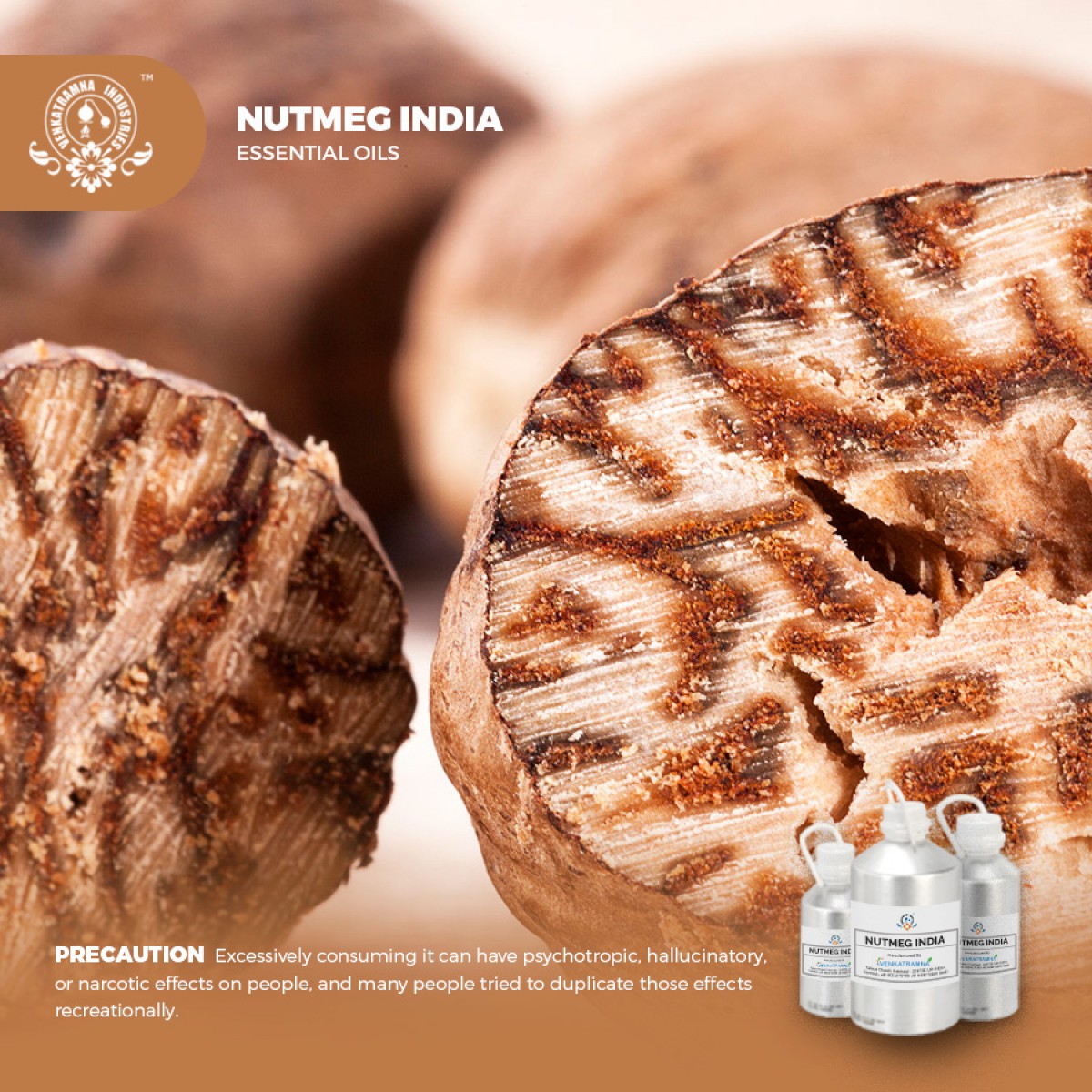Botanical Name: Myristica fragrans Common name: Nutmeg Plant fa Read More
|
Botanical Name: |
Myristica
fragrans |
|
Common name: |
Nutmeg |
|
Plant
family: |
Myristicaceae |
|
Genus: |
Myristica |
|
Appearance/Color: |
Colorless to Pale yellow liquid with thin consistency |
|
Odor: |
Scent
has soft, spicy, and woody with a slightly musky note; with a medium aroma at
a middle note. |
|
Blends With: |
Petitgrain, Lavender, Geranium, Orange, Clary Sage, Rosemary and
other Spice Oils. |
|
Origin: |
India |
|
Source: |
Kernels |
|
Method
of Extraction: |
Hydro-Distillation |
Nutmeg seed
is encased in a mottled yellow, edible fruit which is in the approximate size
and shape of a small peach. The fruit depicts a net-like, bright red covering
over the seed when splited in to half. The aril is collected, dried and sold as
mace. Under the aril is a dark shiny nut-like pit, and inside it is an oval shaped
seed which is called the nutmeg. Nutmegs are usually sold without the mace.
Until the mid-19th century, the small island
group of the Banda Islands, which are also known under the name "Spice
Islands," was the only location of the production of the spices nutmeg and
mace in the world. The Banda Islands are situated in the eastern part of
Indonesia, in the province of Maluku. They consist of eleven small volcanic
islands, called Neira, Gunung Api, Banda Besar, Rhun, Ai, Hatta, Syahrir,
Karaka, Manukan, Nailaka and Batu Kapal, with a total approximate land area of
8,150 hectares.
Nutmeg is a delicate, slightly sweet spice that is widely used in cuisines around the world. The tree is also highly valued because of the essential oils derived from the tree and leaves, and nutmeg butter is also a popular derivative food that packs a healthy punch. The essential oils from nutmeg steam extract are highly beneficial to health and are frequently used in alternative and herbal medicine.
DISCLAIMER
The complete range of conditions
or methods of use are beyond our control therefore we do not assume any
responsibility and expressly disclaim any liability for any use of this
product. Information contained herein is believed to be true and accurate however,
all statements or suggestions are made without warranty, expressed or implied,
regarding accuracy of the information, the hazards connected with the use of
the material or the results to be obtained from the use thereof. Compliance
with all applicable federal, state, and local laws and local regulations
remains the responsibility of the user.
The FDA has not evaluated the
statements on this website. No claims are made by Venkatramna Industries as to
the medicinal value of any products from vriaroma.com or by us. The information
presented here is for educating our customers about the traditional uses of
essential oils and is not intended to diagnose, treat, cure, or prevent any
disease. You are responsible for understanding the safe application of these products.
If you have any questions, please call or email us for further information.
As per NAHA guidelines, New Directions Aromatics
(NDA) does not recommend the ingestion of essential oils. It is imperative to
consult a medical practitioner before using Essential Oils for therapeutic
purposes. Pregnant and nursing women and those taking prescription drugs are
especially advised not to use this product without the medical advice of a
physician. The oil should always be stored in an area that is inaccessible to
children, especially those under the age of 7.
Nutmeg is a popular spice that is widely used
in world famous cuisines. The essential oils obtained from nutmeg steam extract
are very much beneficial to health and are frequently used in alternative and
herbal medicine. Nutmeg oil is traditionally used with honey to improve
digestion and also in the treatment of chronic diarrhoea, constipation,
indigestion gastroenteritis and nausea. It is a digestive system regulator.
Nutmeg oil is used with other aromatic oils
in massages for treatment of chronic soft muscle pain.
It exudes
a warming, relaxing, spicy aroma that energizes mind as well as deeply soothe
senses. Its ability to
cure muscle contractions and pains owns to the sedative nature. For
this reason, Nutmeg essential oil is commonly featured in medicinal and aroma
therapeutic remedies for treating muscular aches and cramps, insomnia, and
anxiety. Nutmeg oil is also known as an
effective anti-inflammatory agent.
It is industrially used in perfumeries and pharmaceuticals.
Nutmeg oil can also improve regulation of heart and blood
circulation in general and uplifting the state of mind and its stimulation
after fainting.
Nutmeg essential oil has extensive uses
in food industry for preparing baked, beverages, syrups and sweets. The sweet
spicy flavour aids for this application.
Even beauty products like creams and gels
are made up of the oil. Toothpastes, cough syrups, and many more, the use-list
of the nutmeg oil is simply endless.
Nutmeg oil has been known to be a tonic
for the regulation of the reproductive system – regulating periods and
relieving frigidity in women and aiding in the treatment of impotence in men.
It is also known to help in childbirth by strengthening muscles to improve
contractions.
Nutmeg oil is used to relieve patients of
rheumatic ailments from severe pain and is also used as an emergency painkiller
in tooth aches. nutmeg oil is a best choice.
Nutmeg oil is a best choice against
nervous problems, vomiting, nausea, kidney problems, diarrhoea, abdominal pain,
bad breath.
It
is also a popular ingredient in cosmetics as well as personal care products,
especially within men's grooming and oral health care. And is reputed for its
anti-inflammatory, antimicrobial, antioxidant, carminative, and cleansing
properties.
COMMON
USAGE
·
Relieves Pain
·
Promotes Digestion
·
Improves Brain Health
·
Detoxifies the Body
·
Oral Health
·
Treats Insomnia
·
Treats Leukemia
·
Skin Care
·
Regulates Blood Pressure
Ingredients:
|
S.No |
Key Constituents |
Strength (%) |
|
1 |
Sabinene |
42.0–57.0 |
|
2 |
a-Pinene |
1.6–12.6 |
|
3 |
b-Pinene |
7.8–12.1 |
|
4 |
Terpinen-4-ol |
3.0–6.4 |
|
5 |
g-Terpinene |
1.7–4.7 |
|
6 |
(þ)-Limonene |
2.9–4.4 |
|
7 |
a-Terpinene |
0.8–4.2 |
|
8 |
b-Myrcene |
2.2–3.4 |
|
9 |
p-Cymene |
0.7–3.2 |
|
10 |
E)-Sabinene hydrate |
0.3–2.4 |
|
11 |
Terpinolene |
1.4–1.7 |
|
12 |
Elemicin |
1.2–1.4 |
|
13 |
a-Thujene |
1.2 |
|
14 |
(Z)-p-Piperitol |
0.4–0.2 |
|
15 |
Myristicin |
0.5–0.9 |
|
16 |
Safrole |
0.1–0.5 |
|
17 |
Methyl eugenol |
0.1–0.2 |
Safety Summary
·
Hazards: Basing
on safrole and methyl eugenol
content it is potentially carcinogenic, and psychotropic in high doses.
·
Cautions: No
information found.
Safety advises
It is recommended
maximum dermal use of 0.8% for the Indian oil based on 3.3% safrole and 1.2%
methyl eugenol content, and 5% for the Indian oil based on 0.5% safrole and
0.2% methyl eugenol content, applying dermal limits of 0.05% and 0.02% for
safrole and methyl eugenol, respectively is recommended. Maximum daily oral
doses are based on 0.025 mg/kg for safrole and 0.01 mg/kg for methyl eugenol.
Organ Specific Effects
·
Adverse skin reaction: Undiluted nutmeg oil was moderately
irritating to rabbits; tested at 2% on 25 volunteers it was neither irritating
nor sensitizing.
·
Neurotoxicity: Since sixteenth century, Nutmeg is well known for its narcotic, intoxicating properties
since the sixteenth century.
·
Reproductive toxicity: Nutmeg oil
is tested at up to 260 mg/kg to pregnant rats for 10 consecutive days, up to
560 mg/kg to pregnant mice for 10 consecutive days, and up to 600 mg/kg to
pregnant hamsters for five consecutive days and it has been observed that no
effect on implantation or on maternal or fetal survival is noticed; no
teratogenic effect was observed in comparison with controls (NTIS 1976).
Sabinene, the main component of Nutmeg oil is not reproductively toxic.
Systemic Effects
·
Acute
Toxicity: Acute oral LD50
has been reported as 2.62 g/kg and 2.6 g/kg in rats, 5.6 g/kg in mice and 6
g/kg in hamsters; acute dermal LD50 in rabbits >10 mL/kg.
·
Antioxidant/pro-oxidant activity: Nutmeg oil has demonstrated significant
antioxidant activity in vitro and in vivo. It showed potent DPPH radical
scavenging activity, with an IC50 of 0.13 mL/Ml.
·
Carcinogenic/anti carcinogenic potential: Nutmeg oil has both rodent carcinogens and
anticarcinogens. Methyl eugenol and safrole are carcinogenic whereas
(þ)-limonene and myristicin display anticarcinogenic activity. Nutmeg oil was
not mutagenic in the Ames test, and did not produce CA in Chinese hamster
fibroblasts. Its dose-dependently inhibited aflatoxin B1-induced adducts in
calf thymus DNA, in the presence of rat liver microsomes. Also, Nutmeg oil
induced glutathione transferase in the mouse liver.
·
Drug interactions: It is a weak inhibitor of MAO and not at a
level suggestive of drug interaction.
·
Ecotoxicity: No data available
·
Bioaccumulation: No data available
·
Mobility in soil: No data available
·
Persistence and degradability: No data available
·
PBT and vPvB assessment: No data available
·
Avoid direct exposure into water streams and
ground water sources.





 MSDS-Nutmeg.pdf
MSDS-Nutmeg.pdf




